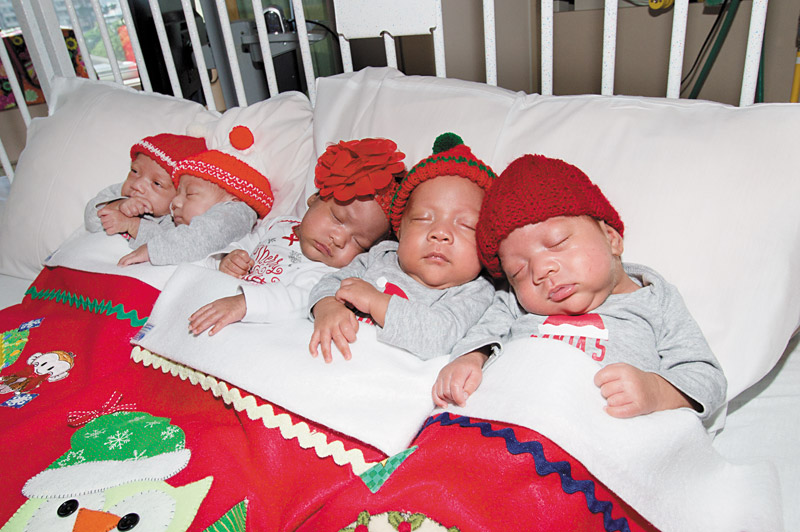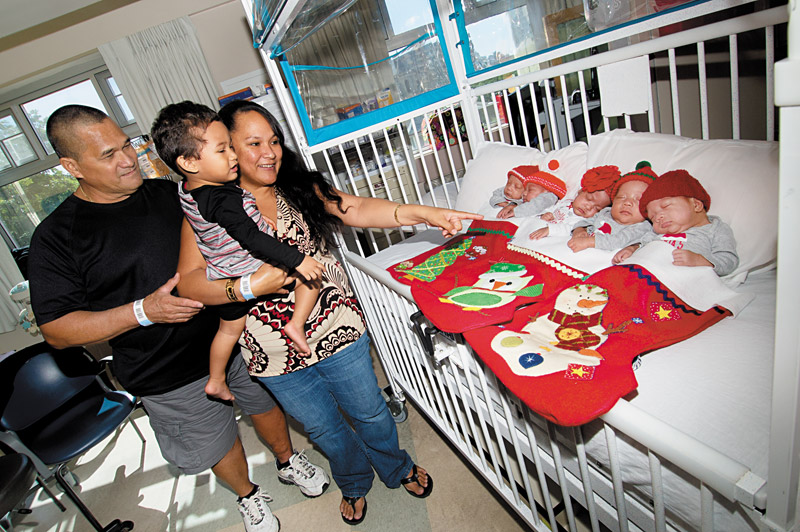A Quints-Essential Christmas
Big brother Makaio Dela Cruz is happy to welcome his five new siblings home in time for Christmas — four identical boys and a girl. Meet Hawaii’s quints (from left) Kapena, Keahi, Kamali‘i, Kaolu and Kupono
A particularly plucky stork visited Ray and Marcie Dela Cruz this past Oct. 10, delivering five little bundles — a girl, Kamali‘i, and four identical quadruplet brothers: Kapena, Kaolu, Keahi and Kupono. With the only set of surviving quintuplets born in the state, the Dela Cruzes are unarguably Hawaii’s busiest set of parents, and their new little bundles of joy are somewhat of a … well, miracle.
It’s rare enough to have quadruplets. The chances are about one in 800,000. The chance of having a set of identical quadruplets is one in 13 million to 15 million. Of course, little Kamali‘i makes five, increasing the overall odds of this particular set of multiples.
“In this case, one embryo split twice — first into two, then each into two again. The other embryo implanted as a singleton making five. … This is much like winning the lottery,” says reproductive endocrinology and infertility specialist Dr. Christopher Huang at Kapiolani Medical Center, where Marcie and her fetuses were treated through pregnancy and delivery, and during the two months the newborns were in the neonatal intensive care unit.
Ray and Marcie already had experienced the procedure once before, implanting two embryos using in vitro fertilization, with the hope of carrying to term a single viable fetus. And it worked. They were blessed with baby boy Makaio in 2013. This second time around, the same procedure resulted in a pentad — the number of keiki you can count on one hand.
“When Ray tells people we had quintuplets,” says Marcie, “they’re like, ‘How many is that?’ After triplets, nobody knows what comes next.”
“It is thought that assisted reproductive technology increases the risk for embryos to split,” notes Huang, “and putting in more embryos obviously increases the chances for multiple gestations.”
The choice the Dela Cruzes had to make was whether to implant one embryo or two.
That’s a weighty decision, as pregnancy rates of a single embryo transfer are slightly lower.
“But the costs of a subsequent transfer if the first is not successful is substantial,” adds Huang. “(It’s) in the thousands of dollars.”
Huang points out that ideally, a patient younger than 35 would transfer a single egg, but insurance costs often preclude that option, with women more commonly choosing to implant more than one embryo. At age 37, Marcie followed suit.
A month after the confirmation came in that she was pregnant, Marcie had a miscarriage scare and rushed to the hospital, only to be notified that she was carrying twins. At her next checkup, a few days later, she was told she was carrying triplets. While at work, Ray, a roofer, got the shocking phone call.
“I told my mom, ‘I hope he doesn’t jump,'” laughs Marcie.
A week later, the ultra-sound showed four. Six weeks later, a fifth showed up on the monitor.
“I was at work on a military base,” says Ray, who was just heading out with his fellow roofers all driving out behind him. He came to a halt in the middle of the road, and when the MP came to see what was wrong, Ray recalls, “I said, ‘I’m just letting my friends know I getting five!’
“Five what?” asks the officer.
“Babies!”
For a time, and even at delivery, a careful check was made to be sure there wasn’t a sixth hiding somewhere in there. Gestation, which is generally 40 weeks with a single baby, is on average 28.2 weeks with multiples. During a checkup at 23 weeks, doctors realized Marcie had begun dilating and was in preterm labor. She was admitted to the hospital where Dr. Janet Burlingame — the maternal and fetal medicine specialist at Kapiolani who specializes in high-risk pregnancies and who headed up Marcie’s delivery team of more than 30 health care providers — was able to delay labor, giving the babies a higher chance of survival. And steroids were administered to lessen complications of prematurity for the babies. While all four boys shared a placenta, the blood supply for two of them was connected in such a way that one was thriving while the growth of the other was restricted. Burlingame removed fluid from the recipient quintuplet to decrease pressure on blood flow and even out the fluid. The procedure was successful, and the baby began to prosper. Then, there was a second preterm labor scare and a second round of steroids.
Making it a few days past the average term of pregnancy for multiples, Marcie went into labor. The delivery team, which had practiced preparation drills, went into action. There was a respiratory therapist, nurse and neonatologist for each baby, and Mom had her own team of specialists — organized action that spread across two delivery rooms, lifting one baby from the womb and passing the child to a pediatrician who placed the baby in a warmer.
“We would go in, find the closest baby, break the water bag, deliver the baby and hand it off to the pediatrician,” says Burlingame, who has seen several sets of triplets in her 10 years at Kapiolani, but no surviving quadruplets or quintuplets. “The family and the Kapiolani team were well-prepared, and the birth had a wonderful outcome. Often these don’t.”
The case of identical quads is rare enough that Burlingame will submit a report for medical literature, she says, adding: “I wish the family well with their one little princess and four identical princes.”
The babies, who barely weighed between 2 and 3 pounds each (normal single baby weight is about 7.5 pounds) at birth, now weigh closer to 6 and 7 pounds each. Immediately after birth, two of the quintuplets required a ventilator for a few days, and then were given breathing and oxygen support along with the other three. All five now are breathing on their own, and three have been discharged, with the other two expected to be home before the end of the month.
“The health markers we look for before discharging them include them being warm in an open crib, which means they are able to maintain their body temperature on their own,” says Dr. Charles Neal, neonatologist and medical director of the NICU at Kapiolani. “And that they are able to feed through a nipple and can do so without having a drop in their oxygen levels, and that they can breathe room air without requiring oxygen.”
Here’s the part that warrants a drum roll: Mom has been breast-feeding all five babies.
“Giving them breast milk early on helped these babies grow faster and healthier,” says Dr. Neal.
MidWeek visits the family at the hospital on the quintuplets’ 2-month birthday, and it’s the first time Mom and Dad have seen all five keiki together.
“The babies are coming, the babies are coming,” excitedly chants wide-eyed, 2-year-old sibling Makaio.
When we are invited to see all five cuddled together in a crib, Marcie turns to Ray with tears and a huge embrace, “Look at our beautiful babies. They’re real, they’re here. I don’t believe it … and they’re big and healthy.”
Makaio is placed in the crib with his siblings and he looks at the squirming bundles, perplexed. Life is about to change drastically for Makaio and his Pauoa family. They’ve bought two strollers (doubleand triple-seaters), a new van, three cribs. The amount of diapers needed before they are potty-trained alone is staggering: 35,000, or 40-60 per day. The family also will be looking for a new home, as their current place only has two bedrooms. They didn’t want the stress of moving during the pregnancy, but now, “It’s going to be hard to move with six elves,” says Marcie, ever upbeat. “The babies don’t take up much space, but their stuff does.”
In addition, there are day-care considerations. Logistics tend to be mind-boggling, as there’s no precedent for quintuplets. For instance, rules for assistance tend to depend on both parents working, but with his new brood and no easy daycare answer, Ray plans to retire from roofing, as it provides inconsistent work, and Marcie will return to her job in the training department at American Savings Bank.
“People think that with five babies, it’s going to be rough,” says Ray, who is no stranger to multiple births, with his mom being a twin, and a second pair of twins and set of triplets in his direct family. “But we’re prepared, and we have to go forward and just take care of them the best we can. I know there are a lot of people having a lot of doubts in us, but we’re going to fool them.”
“When we found out we were having a litter of children,” adds Marcie, “we had this attitude that we’re just going to do it. We’re going to do the best we know how to take care of our family. There are going to be challenges along the way, but we can’t anticipate those things and worry about them. We just have to take it one day at a time, or even one hour at a time, at some points.
“People (who don’t know how the fertility process works) may think that we were irresponsible to have all these babies, but it was a gift we received from God, so we’ll take it. We will take it.”
The Dela Cruzes say that unsolicited outpouring of generosity from friends and the general public has been incredible, such that family and friends encouraged the couple to start a gofundme page (see sidebar for ways to help).
“We don’t expect help from anyone,” says Marcie, “but there are so many people out there who want to help. I had a hard time spending $1,200 for the triple stroller, but then I thought that’s what the donations are for. People are, like, ‘How can we help, what can we do?’ We are very blessed.”
Meanwhile, says Mom, the babies’ personalities already are coming through and she can tell them apart. She’s already begun planning their first birthday (“It will be a huge milestone, given how small and tiny they were at birth”), and she laughs heartily when she thinks about the little girl trying to one day bring a date home. The lucky guy will have all five brothers to contend with.
Christmas is at hand, and both Marcie and Ray hope to have all five newborns home by then. Many of Marcie’s family members have moved off island, but her mom flew in from Molokai and she has two nieces who have been at the ready to help. Ray’s adult children all live on island, but they have extended families of their own. At this stage, the Dela Cruzes aren’t expecting a big family holiday.
“Just an intimate Christmas with a whole bunch of babies,” says Marcie with a smile.
Donations For The Quints:
From diapers to onesies, blankets to binkies, babies are expensive. Here are three ways you can help. Just imagine if each of Mid-Week’s half-million readers donated just $1 to the Dela Cruz family:
• Keiki O Ka Aina in Kalihi (koka.org)
• Kapaa Auto Body in Kailua (230-8777, tina@kapaaautobody.com, or type in the shop name on carwise.com)
The latter two are accepting drop-off donations of diapers, Dreft detergent and more.






